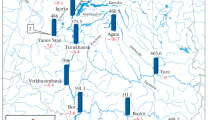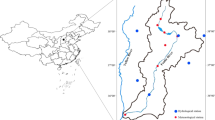Abstract
Increasing pressure on water resources makes it necessary to understand the reasons for the changes in the run-off characteristic of the Ngerengere River in Tanzania during recent years. Changing land use and changes in climate boundaries are identified as effects. A combination of statistical analysis and the use of the hydrological model SWAT were chosen to handle the problem of poor data quantity and quality with non-overlapping periods. Changes in the discharge regime were identified with the 5th percentile of the flow duration curve as an indicator for high-flow events, with an indicator for low-flow duration and with the base flow index. The analysis showed that climate boundaries and changing land use do not have a uniform effect on discharge in the catchment. Changing land use affects surface run-off and increases floods in the mountainous areas. Changes in climate boundaries increase the duration of low flow and no flow in the Ngerengere catchment. Changes in climate conditions and land use had antipodal effects on parts of the discharge regime. Thus, the observed changes in land use and climate conditions partially compensate for each other.







Similar content being viewed by others
References
Arnold JG, Fohrer N (2005) SWAT2000: current capabilities and research opportunities in applied watershed modelling. Hydrol Process 19(3):563–572
Arnold JG, Allen PM, Muttiah R, Bernhardt G (1995) Automated base–flow separation and recession analysis techniques. Ground Water 33(6):1010–1018
Arnold JG, Srinivasan R, Muttiah RS, Williams JR (1998) Large area hydrologic modeling and assessment—part 1: model development. J Am Water Resour Assoc 34(1):73–89
Batjes NH (2004) SOTER–based soil parameter estimates for Southern Africa. ISRIC—World Soil Information 2004/04, Wageningen
Bronaugh D, Werner A (2009) ‘Zyp’ package—Zhang + Yue–Pilon trends package. http://www.r-project.org
Bruijnzeel LA (1990) Hydrology of moist tropical forests and effects of conversion: a state of knowledge review. UNESCO. IHP humid tropics programme series 2. Paris
Calder IR (2002) Forests and hydrological services: reconciling public and science perceptions. Land Use Water Resour Res 2(2):1–12
FAO (1994) Map of annual rainfall. FAO. http://www.fao.org/geonetwork/srv/en/metadata.show?id=3829&currTab=simple
FAO (2004) Map of reference evapotranspiration. FAO. http://www.fao.org/climatechange/54638/en/
Githui FW (2008) Assessing the impacts of environmental change on the hydrology of the Nzoia catchment, in the Lake Victoria Basin Department of Hydrology and Hydraulic. Engineering Faculty of Engineering, Vrije Universiteit Brussel Brussels, Brussels
Gomani MC, Dietrich O, Lischeid G, Mahoo H, Mahay F, Mbilinyi B, Sarmett J (2010) Establishment of a hydrological monitoring network in a tropical African catchment: an integrated participatory approach. Phys Chem Earth 35(13–14):648–656
Gross J (2009) ‘Nortest’ package—tests for normality. http://cran.r-project.org/web/packages/nortest/index.html
Holländer HM, Blume T, Bormann H, Buytaert W, Chirico GB, Exbrayat JF, Gustafsson D, Hölzel H, Kraft P, Stamm C, Stoll S, Blöschl G, Flühler H (2009) Comparative predictions of discharge from an artificial catchment (Chicken Creek) using sparse data. Hydrol Earth Syst Sci 13(11):2069–2094
Jarvis A, Reuter HI, Nelson A, Guevara E (2006) Hole–filled seamless SRTM data V3. International Centre for Tropical Agriculture (CIAT), Colombia, USA
Kashaigili J (2008) Impacts of land–use and land–cover changes on flow regimes of the Usangu wetland and the Great Ruaha River, Tanzania. Phys Chem Earth 33(8–13):640–647
McLeod AI (2011) ‘Kendall’ package—Kendall rank correlation and Mann–Kendall trend test. http://www.stats.uwo.ca/faculty/aim
Moriasi DN, Arnold JG, Van Liew MW, Bingner RL, Harmel RD, Veith TL (2007) Model evaluation guidelines for systematic quantification of accuracy in watershed simulations. Trans Asabe 50(3):885–900
MPEE (2007) Morogoro region—socio–economic profile. Ministry of Planning, Economy and Empowerment, Dar Es Salaam
Mtalo F, Mulungu D, Mwanuzi F, Mkhandi S, Kimaro T, Valimba P (2005) Hydrological analysis for the Eastern ArcMountain forests. Conservation and Management of the Eastern Arc Mountain Forests—Forestry and Beekeeping Division, Dar er Salam
Mulungu DMM, Munishi SE (2007) Simiyu River catchment parameterization using SWAT model. Phys Chem Earth 32(15–18):1032–1039
Mwakalila S (2005) Water resource use in the Great Ruaha Basin of Tanzania. Phys Chem Earth 30(11–16):903–912
Mwakalila S (2011) Vulnerability of people’s livelihoods to water resources availability in semi arid areas of Tanzania. J Water Resour Prot 3:678–685
Mwamila TB, Kimwaga RJ, Mtalo FW (2008) Eco–hydrology of the Pangani River downstream of Nyumba ya Mungu reservoir, Tanzania. Phys Chem Earth 33(8–13):695–700
Natkhin M, Steidl J, Dietrich O, Dannowski R, Lischeid G (2012) Differentiating between climate effects and forest growth dynamics effects on decreasing groundwater recharge in a lowland region in Northeast Germany. J Hydrol 448–449:245–254
Ndomba PM, Mtalo FW, Killingtveit A (2005) The suitability of SWAT model in sediment yield modeling for ungauged catchments: a case of Simiyu River subcatchment, Tanzania. In: 3rd International SWAT Conference 61–69, Zürich
Ndomba P, Mtalo F, Killingtveit A (2008) SWAT model application in a data scarce tropical complex catchment in Tanzania. Phys Chem Earth 33(8–13):626–632
Neitsch SL, Arnold JG, Kiniry JR, Srinivasan R, Williams JR (2009) Soil and water assessment tool—input/output file documentation Grassland, Texas Water Resources Institute Technical Report No. 365, Texas A&M University, Texas
Nyenzi BS, Kiangi PMR, Rao NNP (1981) Evaporation values in East-Africa. Arch Meteorol Geophys Bioclimatol Ser B Theor Appl Climatol 29(1–2):37–55
Palamuleni GL, Ndomba PM, Annegarn HJ (2011) Evaluating land cover change and its impact on hydrological regime in Upper Shire river catchment, Malawi. Reg Environ Change 11(4):845–855
R Development Core Team (2006) R: a language and environment for statistical computing. R Foundation for Statistical Computing, Vienna, Austria
Sarmett J, Anderson E, Mandari A (2008) Wami River Sub–Basin, Tanzania—initial environmental flow assessment. Wami–Ruvu Basin Water Office, Tanzania
Sen PK (1968) Estimates of the regression coefficient based on Kendall’s tau. J Am Stat Assoc 63:1379–1389
Smakhtin VU (2001) Low flow hydrology: a review. J Hydrol 240(3–4):147–186
Thornton PK, Jones PG, Owiyo T et al (2006) Mapping climate vulnerability and poverty in Africa. Report to the Department for International Development. Department for International Development, ILRI, Nairobi
Valimba P (2008) Temporal flow variations: a challenge for water management in Tanzania. In: GLOBAL CHANGES and WATER RESOURCES: confronting the expanding and diversifying pressures. IWRA, Montpellier, France. http://www.iwra.org/congress/2008
Vogel RM, Fennessey NM (1994) Flow–duration curves. I: new interpretation and confidence intervals. J Water Resour Plan Manag 120((4):485–504
Yanda PZ, Munishi PKT (2007) Hydrologic and land use/cover change analysis for the Ruvu River (Uluguru) and Sigi River (East Usambara) Watersheds. Dar es Salaam. Eastern Arc Mountains Conservation Endowment Fund (EAMCEF), Morogoro, Tanzania. http://easternarc.or.tz/downloads/Uluguru/Final%20Report%20Revised_20_04_2007.pdf
Yapo PO, Gupta HV, Sorooshian S (1996) Automatic calibration of conceptual rainfall–runoff models: sensitivity to calibration data. J Hydrol 181(1–4):23–48
Yue S, Pilon P, Phinney B, Cavadias G (2002) The influence of autocorrelation on the ability to detect trend in hydrological series. Hydrol Process 16(9):1807–1829
Zambrano–Bigiarini M (2011) ‘hydroTSM’ package—time series management, analysis and interpolation for hydrological modelling. http://cran.r-project.org/web/packages/hydroTSM/
Zhao G, Hörmann G, Fohrer N, Zhang Z, Zhai J (2010) Streamflow trends and climate variability impacts in Poyang Lake Basin, China. Water Resour Manag 24:689–706
Acknowledgments
The work reported here was undertaken as part of the project ”Resilient Agro-landscapes to Climate Change in Tanzania (ReACCT)” funded by the Federal Ministry for Economic Cooperation and Development (BMZ) and Deutsche Gesellschaft für Internationale Zusammenarbeit (GIZ) under a Research Program: “Adaptation of African Agriculture to Climate Change”. The authors would like to thank the WRBWO, TMA, Sokoine University of Agriculture and University of Dar es Salam for their support.
Author information
Authors and Affiliations
Corresponding author
Rights and permissions
About this article
Cite this article
Natkhin, M., Dietrich, O., Schäfer, M.P. et al. The effects of climate and changing land use on the discharge regime of a small catchment in Tanzania. Reg Environ Change 15, 1269–1280 (2015). https://doi.org/10.1007/s10113-013-0462-2
Received:
Accepted:
Published:
Issue Date:
DOI: https://doi.org/10.1007/s10113-013-0462-2




